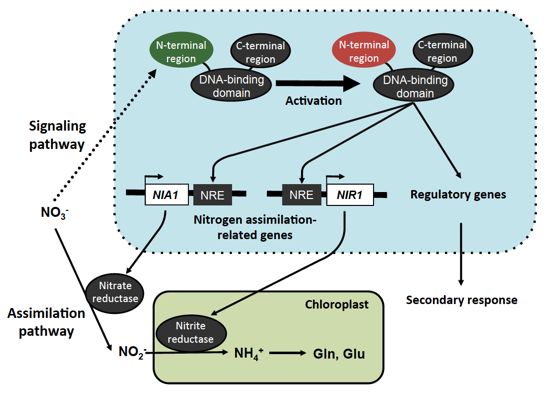Molecular mechanism for nitrate signaling and response in plants
Plants are autotrophs that take up inorganic compounds (nitrogen and carbon) and biosynthesize organic compounds that are necessary for growth and reproduction. Nitrate is the major nitrogen source for plants, and also functions as a signaling molecule. Nitrate induces the expression of numerous genes, including genes related to nitrate assimilation and genes encoding proteins with regulatory functions. Thus, nitrate is involved in the genetic regulation of nitrate assimilation, plant development, lateral root elongation, the shoot/root ratio, and phytohormone biosynthesis. Plants adapt to diverse nutrient conditions through nitrate-mediated regulation. Although nitrate-mediated regulation has an essential role in controlling plant growth and development, molecular mechanisms underlying nitrate signaling and response remain to be elucidated.
We identified the nitrate-responsive cis-element (NRE) in the promoters of genes related to nitrate assimilation pathways (Plant J. 63, 269-282, 2010; Plant Cell Physiol. 52, 824-836, 2011). Subsequent work showed that NIN-like protein (NLP) transcription factors bind to NRE sequences and promote transcription from the nitrate-responsive promoters (Nat. Commun. 4, 1617, 2013). Most nitrate-responsive gene expression was attenuated by suppressing NLP transcription factor activity, suggesting that NLP transcription factors are key regulators of nitrate-responsive gene expression in plants (Nat. Commun. 4, 1617, 2013). Recent work identified the molecular mechanism underlying post-translational activation of NLP transcription factors (Nature, in press, 2017).

Publications (selected)
- Konishi M, Yanagisawa, S. (2013) Arabidopsis NIN-like transcription factors play a central role in nitrate signalling. Nat. Commun. 4: 1617. [Abstract]
- Sawaki N, Tsujimoto R, Shigyo M, Konishi M, Toki S, Fujiwara T, Yanagisawa S. (2013) A nitrate-inducible GARP family gene encodes an auto-repressible transcriptional repressor in rice. Plant Cell Physiol. 54: 506-517. [Abstract]
- Konishi M, Yanagisawa S. (2011) Roles of the transcriptional regulation mediated by the nitrate-responsive cis-element in higher plants. Biochem. Biophys. Res. Commun. 411: 708–713. [Abstract]
- Konishi M, Yanagisawa S. (2011) The regulatory region controlling the nitrate-responsive expression of a nitrate reductase gene, NIA1, in Arabidopsis. Plant Cell Physiol. 52: 824-836. [Abstract]
- Konishi M, Yanagisawa S. (2010) Identification of the nitrate-responsive cis-element in the Arabidopsis NIR1 promoter defines the presence of multiple cis-elements for nitrogen response. Plant J. 63: 269-282. [Abstract]
- Kato Y, Konishi M, Shigyo M, Yoneyama T, Yanagisawa S. (2010) Characterization of plant eukaryotic translation initiation factor 6 (eIF6) genes: The essential role in embryogenesis and their differential expression in Arabidopsis and rice. Biochem. Biophys. Res. Commun. 397: 673-678. [Abstract]
Link
-
Todai Research
The plant mechanism controlling nitrogen utilization




